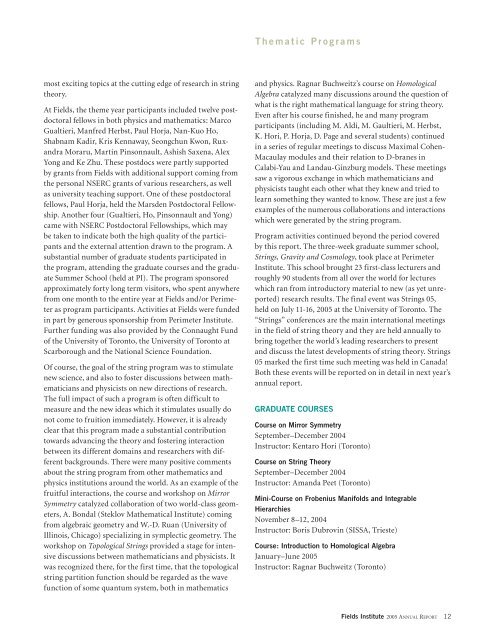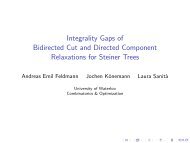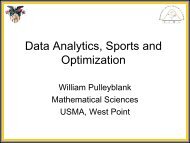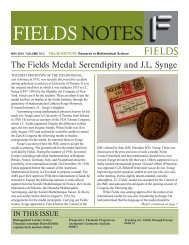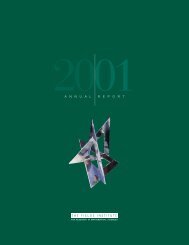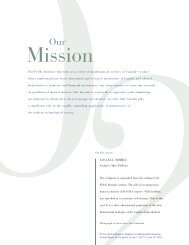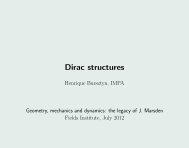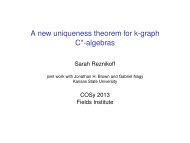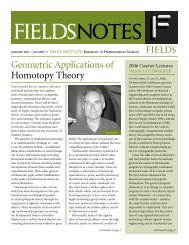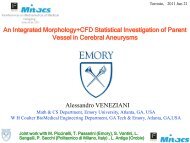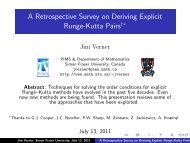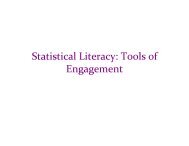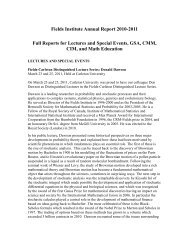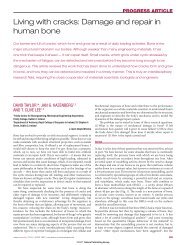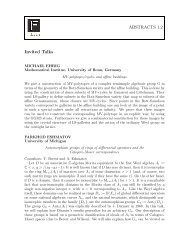Annual Report 2005 - Fields Institute - University of Toronto
Annual Report 2005 - Fields Institute - University of Toronto
Annual Report 2005 - Fields Institute - University of Toronto
You also want an ePaper? Increase the reach of your titles
YUMPU automatically turns print PDFs into web optimized ePapers that Google loves.
most exciting topics at the cutting edge <strong>of</strong> research in string<br />
theory.<br />
At <strong>Fields</strong>, the theme year participants included twelve postdoctoral<br />
fellows in both physics and mathematics: Marco<br />
Gualtieri, Manfred Herbst, Paul Horja, Nan-Kuo Ho,<br />
Shabnam Kadir, Kris Kennaway, Seongchun Kwon, Ruxandra<br />
Moraru, Martin Pinsonnault, Ashish Saxena, Alex<br />
Yong and Ke Zhu. These postdocs were partly supported<br />
by grants from <strong>Fields</strong> with additional support coming from<br />
the personal NSERC grants <strong>of</strong> various researchers, as well<br />
as university teaching support. One <strong>of</strong> these postdoctoral<br />
fellows, Paul Horja, held the Marsden Postdoctoral Fellowship.<br />
Another four (Gualtieri, Ho, Pinsonnault and Yong)<br />
came with NSERC Postdoctoral Fellowships, which may<br />
be taken to indicate both the high quality <strong>of</strong> the participants<br />
and the external attention drawn to the program. A<br />
substantial number <strong>of</strong> graduate students participated in<br />
the program, attending the graduate courses and the graduate<br />
Summer School (held at PI). The program sponsored<br />
approximately forty long term visitors, who spent anywhere<br />
from one month to the entire year at <strong>Fields</strong> and/or Perimeter<br />
as program participants. Activities at <strong>Fields</strong> were funded<br />
in part by generous sponsorship from Perimeter <strong>Institute</strong>.<br />
Further funding was also provided by the Connaught Fund<br />
<strong>of</strong> the <strong>University</strong> <strong>of</strong> <strong>Toronto</strong>, the <strong>University</strong> <strong>of</strong> <strong>Toronto</strong> at<br />
Scarborough and the National Science Foundation.<br />
Of course, the goal <strong>of</strong> the string program was to stimulate<br />
new science, and also to foster discussions between mathematicians<br />
and physicists on new directions <strong>of</strong> research.<br />
The full impact <strong>of</strong> such a program is <strong>of</strong>ten difficult to<br />
measure and the new ideas which it stimulates usually do<br />
not come to fruition immediately. However, it is already<br />
clear that this program made a substantial contribution<br />
towards advancing the theory and fostering interaction<br />
between its different domains and researchers with different<br />
backgrounds. There were many positive comments<br />
about the string program from other mathematics and<br />
physics institutions around the world. As an example <strong>of</strong> the<br />
fruitful interactions, the course and workshop on Mirror<br />
Symmetry catalyzed collaboration <strong>of</strong> two world-class geometers,<br />
A. Bondal (Steklov Mathematical <strong>Institute</strong>) coming<br />
from algebraic geometry and W.-D. Ruan (<strong>University</strong> <strong>of</strong><br />
Illinois, Chicago) specializing in symplectic geometry. The<br />
workshop on Topological Strings provided a stage for intensive<br />
discussions between mathematicians and physicists. It<br />
was recognized there, for the first time, that the topological<br />
string partition function should be regarded as the wave<br />
function <strong>of</strong> some quantum system, both in mathematics<br />
T h e m a t i c P r o g r a m s<br />
and physics. Ragnar Buchweitz’s course on Homological<br />
Algebra catalyzed many discussions around the question <strong>of</strong><br />
what is the right mathematical language for string theory.<br />
Even after his course finished, he and many program<br />
participants (including M. Aldi, M. Gaultieri, M. Herbst,<br />
K. Hori, P. Horja, D. Page and several students) continued<br />
in a series <strong>of</strong> regular meetings to discuss Maximal Cohen-<br />
Macaulay modules and their relation to D-branes in<br />
Calabi-Yau and Landau-Ginzburg models. These meetings<br />
saw a vigorous exchange in which mathematicians and<br />
physicists taught each other what they knew and tried to<br />
learn something they wanted to know. These are just a few<br />
examples <strong>of</strong> the numerous collaborations and interactions<br />
which were generated by the string program.<br />
Program activities continued beyond the period covered<br />
by this report. The three-week graduate summer school,<br />
Strings, Gravity and Cosmology, took place at Perimeter<br />
<strong>Institute</strong>. This school brought 23 first-class lecturers and<br />
roughly 90 students from all over the world for lectures<br />
which ran from introductory material to new (as yet unreported)<br />
research results. The final event was Strings 05,<br />
held on July 11-16, <strong>2005</strong> at the <strong>University</strong> <strong>of</strong> <strong>Toronto</strong>. The<br />
“Strings” conferences are the main international meetings<br />
in the field <strong>of</strong> string theory and they are held annually to<br />
bring together the world’s leading researchers to present<br />
and discuss the latest developments <strong>of</strong> string theory. Strings<br />
05 marked the first time such meeting was held in Canada!<br />
Both these events will be reported on in detail in next year’s<br />
annual report.<br />
GRADUATE COURSES<br />
Course on Mirror Symmetry<br />
September–December 2004<br />
Instructor: Kentaro Hori (<strong>Toronto</strong>)<br />
Course on String Theory<br />
September–December 2004<br />
Instructor: Amanda Peet (<strong>Toronto</strong>)<br />
Mini-Course on Frobenius Manifolds and Integrable<br />
Hierarchies<br />
November 8–12, 2004<br />
Instructor: Boris Dubrovin (SISSA, Trieste)<br />
Course: Introduction to Homological Algebra<br />
January–June <strong>2005</strong><br />
Instructor: Ragnar Buchweitz (<strong>Toronto</strong>)<br />
<strong>Fields</strong> <strong>Institute</strong> <strong>2005</strong> ANNUAL REPORT 12


